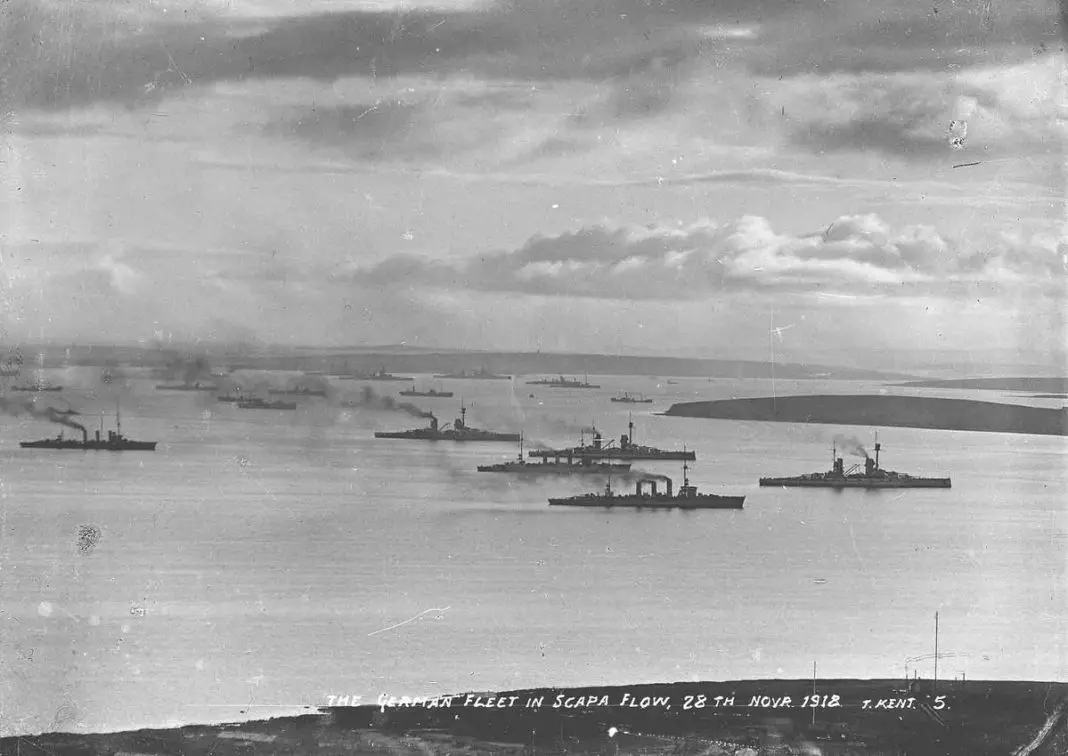2020 will be few people’s idea of a great year for diving, or very much else. Now that the first tentative shoots of recovery from the COVID-19 pandemic are beginning to germinate in many places, we can finally allow ourselves the luxury of planning some great diving.
For those of you who like adventurous diving, historic wrecks, and amazing wildlife, Scapa Flow, in the Orkney Islands, off Scotland’s north coast, will probably be on your wish list. The story of this site has been written about hundreds of times and it is not my intention to go very far down that route. Briefly, at the end of the First World War, the German high seas fleet was interred in the great natural harbor of Scapa Flow to await the outcome of the prolonged armistice negotiations. On the 21st of June 1919, the fleet commander, Rear Admiral Ludwig Von Reuter suspected that the British would try to seize the fleet before an agreement was reached and ordered the entire fleet of 74 ships to be scuttled. It was the greatest act of naval suicide in history.
Although many of the ships were subsequently salvaged, 8 remain. These, along with wreckage from salvage sites, wrecks from other naval activity, as well as civilian wrecks, make Scapa Flow a wreck diver’s paradise. The question is, how do you dive them?
I have been visiting Scapa Flow for over 30 years, both as a diver and boat skipper. Whilst I have read a great deal about the wrecks themselves, advice about the practicalities of diving the site can sometimes be harder to find. So based on my own experience and those of dive industry colleagues, I would like to offer a few hints and tips to enable you to get the most from a trip here.
Location
Environment
Scapa Flow is a stretch of water roughly 120 square miles in size, which is mostly enclosed by the southern islands of the Orkney archipelago. The islands are situated just off the north coast of Scotland at a latitude of 59 degrees north. In case you were in any doubt, this is not a tropical location! But neither is it a blizzard-lashed wilderness. The climate is quite mild, certainly more so than mainland Scotland. Bringing clothes that you can layer will give the best option for warmth. It can rain heavily and be warm and sunny minutes later and the wind is a fairly constant feature. Since the Flow is encircled by islands, there is usually the option of some shelter.
The Islands have a population of just over 20,000, and local infrastructure is excellent, with shops, restaurants, healthcare, and good public transport available. Should you happen to ascend upside down and on fire, there is a recompression chamber and brand-new hospital. Of course, we would rather you did your best to avoid these facilities. More about that later…
At its deepest, Scapa Flow is 60m (197ft), although the deepest of the German wrecks lies in 47m (154ft). The site seems to have gained a reputation for being dark and murky. Visibility can be variable but is regularly in excess of 15m (50ft). The temperature can reach 19 Celsius (66F) at the surface in high summer, reducing with depth, so good thermal protection is vital, especially early in the season. Drysuits are the norm here. Occasionally wetsuit users show up, and generally regret their choice by day 2!
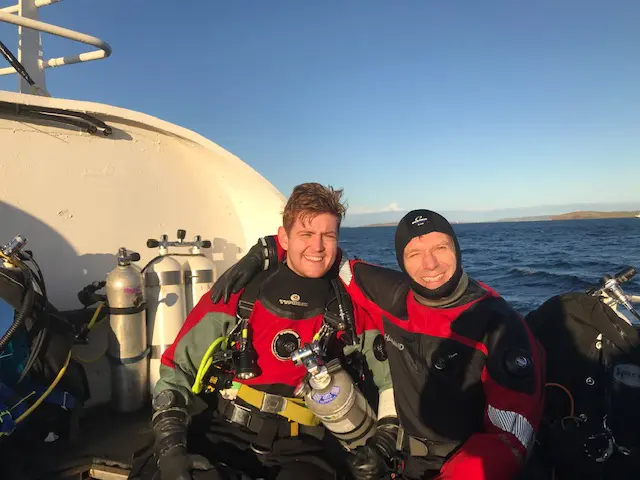
Despite being largely enclosed, Scapa Flow is tidal. If you have never dived in a tidal stream, you are strongly advised to do so before you get here. We see this particular issue surprisingly often.
Orkney is a haven for wildlife. The wrecks are festooned with many different fish species. Whales and dolphins are a regular sight, including orcas, and seals often join divers on their decompression stops.
Boat Life
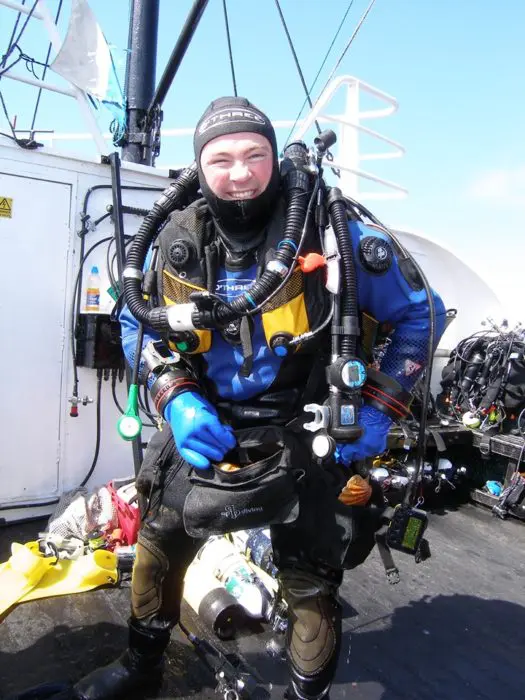
All the wrecks are reached by boat from the harbor at Stromness. Some boats are liveaboards, others are day boats, which also provide onshore accommodation. All are skippered (captained) by experienced people with extensive diving experience and vast wreck knowledge. In addition, our vessel is also crewed by a friendly, if manipulative border collie called Dug. You should expect a thorough briefing on every wreck before diving it, including its layout, history, points of special interest, and potential hazards. Air, Nitrox, and Trimix should be available on every boat. You do not need to be trimix trained to dive these wrecks, but it can be of benefit, and the use of nitrox is highly recommended. The boats leave the dock around 8 am, and skippers decide amongst themselves and their divers, which wrecks they will visit. Generally speaking, we try to avoid any more than 2 boats per wreck at any given time. The norm is 2 dives per day with a good surface interval for lunch.
The boat crew are there to make your trip as enjoyable as possible, but also as safe as possible. If they ask you to do or not do something, there will be a good reason. Please comply with their instructions.
On our boat, we give regular updates on the travel time to the site so that divers can be ready to jump in as soon as we reach our destination. Thinking about getting into your suit when there are five minutes to go is not a good idea.
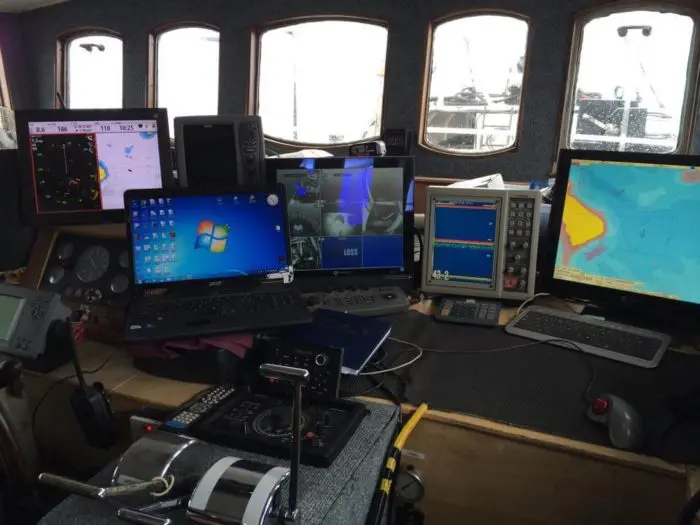
Most boat crews will give you a tour of the bridge or engine room if you ask for one, although they need to concentrate during working diver operations.
The Lowdown On Diving Practices
Your crew will make your experience as hassle-free as they can, but divers visiting Scapa Flow need to play their part too.
Your equipment and skillset must be up to the task. As previously mentioned, a drysuit, and the skill to use it, are important for comfort here. You should understand how to use your computer, including for decompression. A good torch and back up torch are essential, both for the dive, and potentially signaling to the boat. The wrecks are no-fishing zones, but a good cutting tool is a must, as it should be for any wreck dive, in case of any illegal ‘ghost’ line. Please check that it actually cuts. You must be proficient in using a delayed surface marker buoy (DSMB), and in being able to control your buoyancy. There are many designs of DSMB. Remember, surface conditions are not always perfect, so a tall, bright buoy is best, preferably marked with your name. Please, not a black one, or a lift bag, as they are practically invisible in these waters. A spare buoy and spool are also advised.
Entry to the water is by giant stride from the boat. If you have never done this, you are advised to practice (yes, it’s happened). The boats do not anchor into the wrecks. These wrecks are a world heritage site, with the same protection as the pyramids of Egypt, and you wouldn’t drop an anchor on them. In fact, anchoring is very unusual in UK waters, due to the tidal streams. Each wreck has at least one fixed shotline, tied to the wreck with buoys on the surface. The boat skipper will drop you as close to the buoys as is safe. If there is some tidal flow, you will be dropped up tide to assist you in reaching the buoy. Please, please look at the buoy as you swim towards it, or you will just drift past it: then you may learn some new nautical vocabulary, as your skipper picks you up and drops you in again. I have picked up the same diver 3 times for this reason…
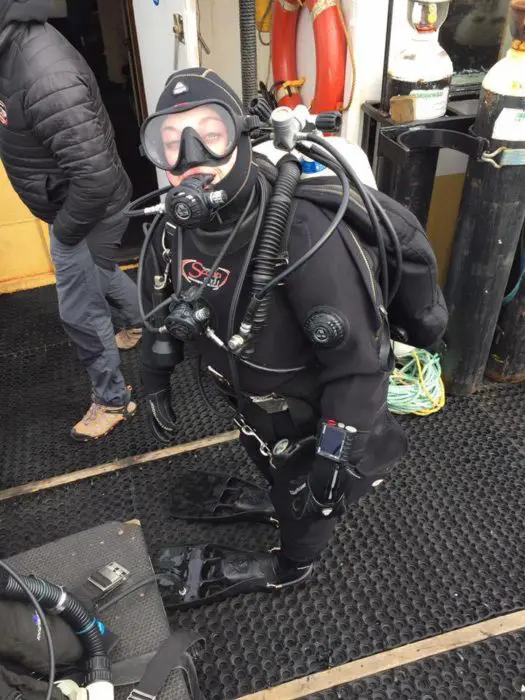
Descend the shotline carefully. Look where you are going. Serious accidents have occurred when decompressing divers have been injured by divers carelessly descending. You may like to consider the use of a Jon line if you come back up the shotline. Let the crew know your dive plan in advance. Most will not set any formal limits unless your plan is obviously insane (this has happened more than once), but it’s clearly sensible to let the crew know your intentions. Then enjoy your dive.
Ascents are made either up the shotline or via DSMB. This is usually your choice, but the skipper may advise one or the other. With several boats working wrecks in close proximity, you may be asked to give a particular signal to your boat upon surfacing, as all we can see is your head with a mask on. Be advised to do so clearly. Please also learn which boat is yours. Every year, we pick up divers who have forgotten to signal but put themselves on our dive lift. Some are actually taking off their gear before they realize that they’re on the wrong boat! Please be aware that a 200-ton boat with a 5-foot-wide propeller is not going to pick you up if you keep hanging on to the shot buoy. So as the boat approaches, let go and drift. Do not swim, as we need to be able to accurately aim and put the dive lift beside you. Relax, we’ll come to you.
In the event of you feeling unwell after a dive, it is your responsibility to inform the crew straight away. All the boats carry oxygen and extensive first aid kits. On our boat, all crew are diver medic or paramedic qualified. Emergencies are rare, but they do occur. In this event, please follow the crew’s instructions without hesitation. They know their stuff.
Hazards
The wrecks of Scapa Flow are generally safe and enjoyable to dive. But it should be remembered that they are now over 100 years old, and not as solid as they once were. Even if you are well trained and experienced in wreck penetration, listen carefully to your pre-dive briefing, as some areas of the wrecks are not considered safe to enter. When entering any overhead environment, always line off and avoid disturbing any silt. Do not swim out of sight of daylight unless you are trained and current in those skills. A course 15 years ago is not good enough.
Be careful about DSMB deployment. I can think of no earthly reason why anyone would want to fire one up the shotline, but we see it regularly, and it can be very dangerous for any divers who are ascending the line or decompressing on it.
We do not allow our divers in the water with orcas. While there is no record of them attacking anyone, I have seen what they can do to a seal. If you had seen the same thing, you wouldn’t get in the water with them. Exclusively fish-eating orcas, maybe. Seal eaters, nope.
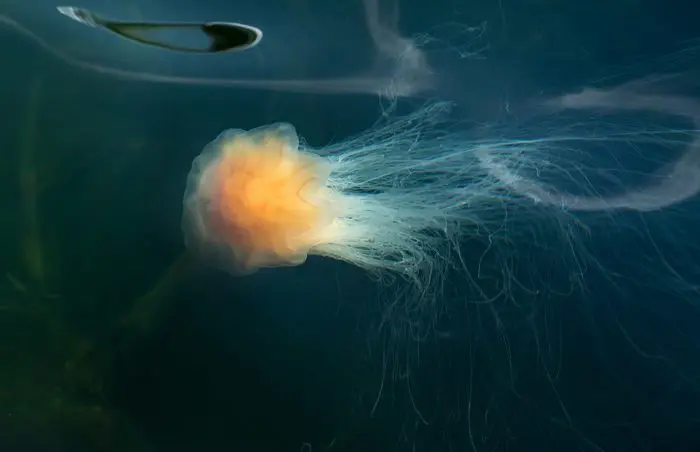
Our only ‘dangerous’ species is the lion’s mane jellyfish (Cyanea capillata). This beautiful creature has tentacles that can reach 30m (100ft) in length and can give quite a painful sting. The tentacles can detach and still be active so watch out for them caught on shotlines. Gloves are advised at all times.
Whilst not exhaustive, this advice should help to ensure that your visit to Scapa Flow is a more pleasurable and relaxed one. We welcome divers from all over the world to dive our stunning wrecks. I hope you’ll join us soon.

